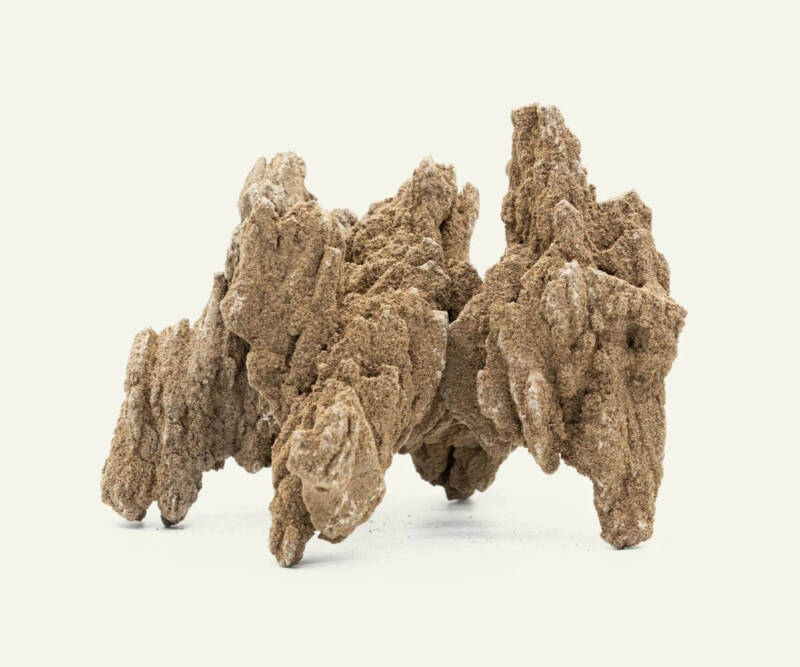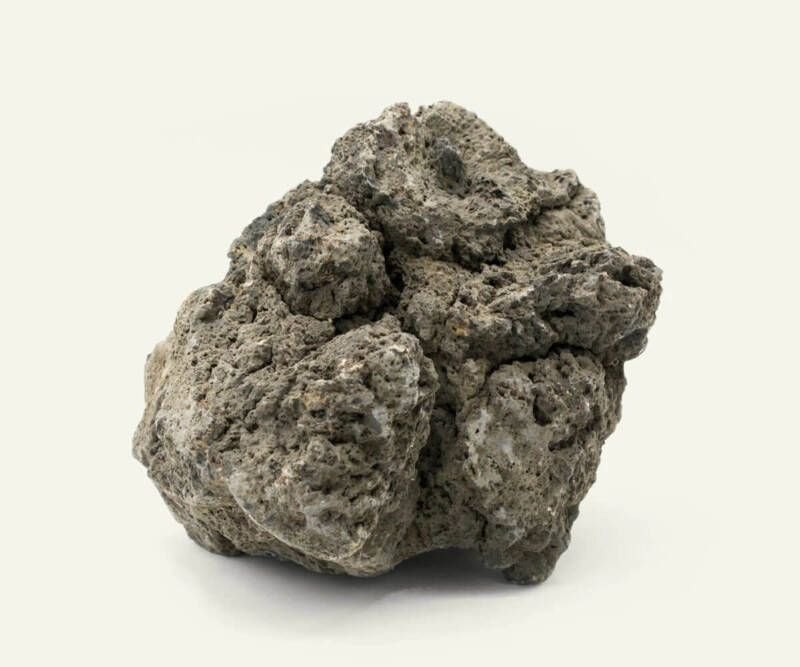Adding rocks to an aquarium serves several purposes and can enhance both the aesthetic appeal and functionality of the aquarium.
Rocks can create a visually appealing and natural-looking environment in the fish tank. They add texture, depth, and dimension to the aquascape, mimicking natural habitats like rivers, streams, or rocky shores. Well-placed rocks can provide a visually pleasing backdrop for plants, fish, and other tank inhabitants
Creating a realistic, underwater landscaped design for your aquarium is a popular feature many people dream of. Commonly known as aquascaping, where you “build” your underwater environment using natural elements like rocks, large jagged stones, driftwood and plants.
Aquarium rocks are the base foundation of this underwater garden design but also have many other benefits for your fish too.
Some benefit of rocks are to create hiding places and shelter, breeding and spawning crevasses, biological filtration, anchoring for plants, fish enrichment and surfaces for algae and biofilm to grow – a key food source to many fish and shrimp species.
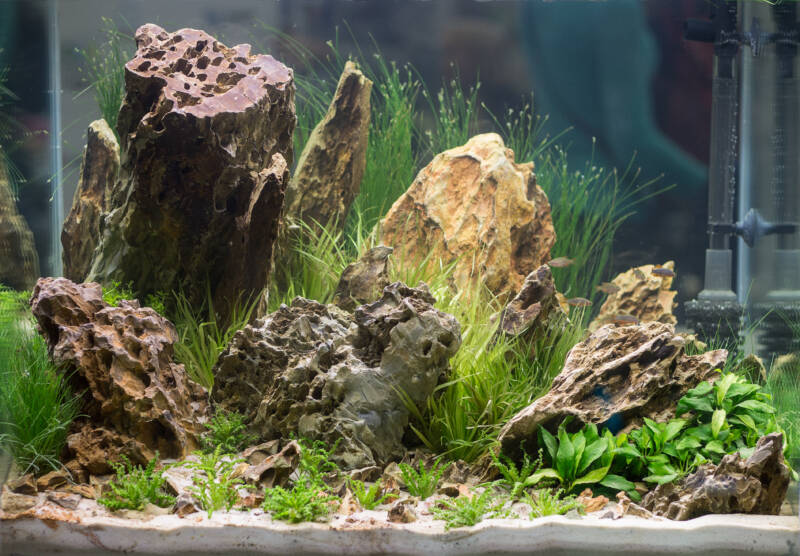
However, not all rock materials are appropriate for aquarium use. It also depends on the type of aquarium and the range of aquatic life.
We’ll examine the types of rock you can use in freshwater and marine aquariums. Then we’ll discuss how to use these rock-based materials to create a fun and attractive aquascape.
[toc]
Using Rock in Freshwater Aquariums
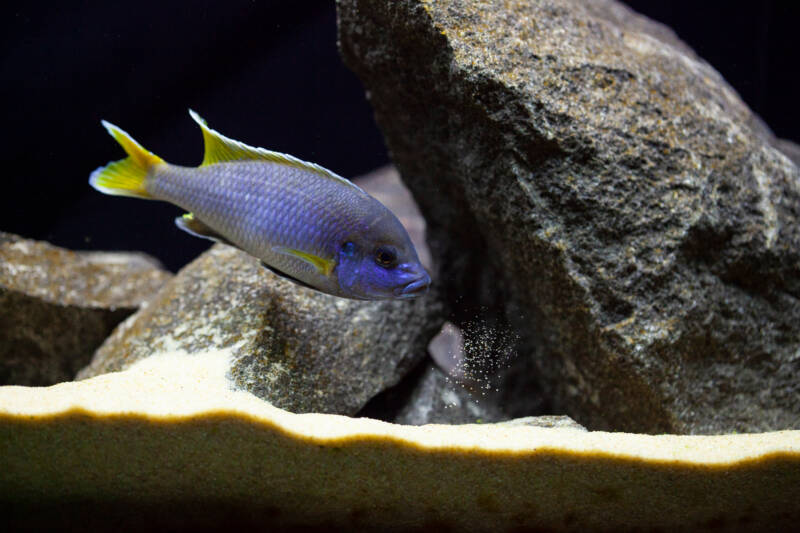
Rocks and stones have always been popular decorative materials for freshwater tanks. Small smooth pebbles add variety to an otherwise flat gravel bed. A single beautiful stone or piece of glass will create a beautiful centerpiece in a betta aquarium.
While there are no set rules for aquascaping with rock, there are a few things to consider. When stacking rock or making caves and overhangs, make sure the rock pile is stable.
A rock collapse can crack the aquarium glass or damage a heater. You can use an aquatic epoxy glue that cements the rocks together, even underwater. This special epoxy is sold for mounting corals onto carbonate rock in reef aquariums.
Types of Rocks
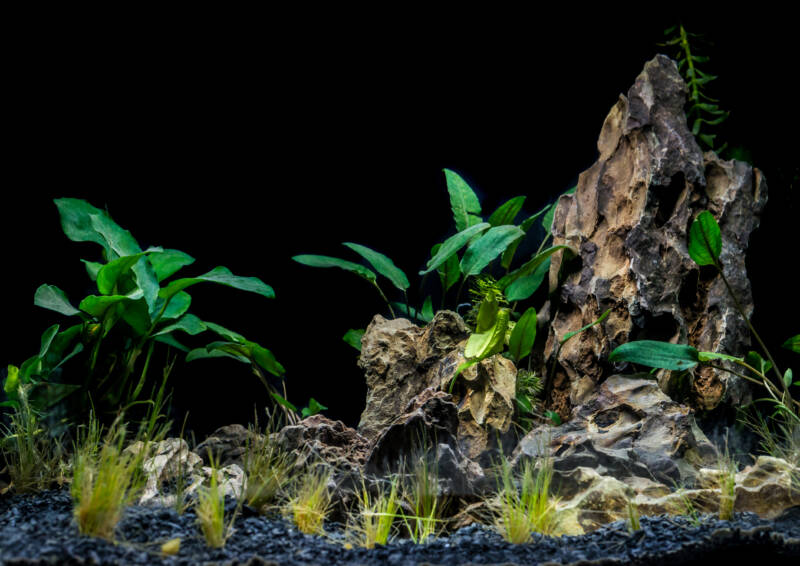
You’ll discover many different types of rock and stone materials available in pet shops, online, and even in nature. But not all aquarium-safe rocks are right for every aquarium.
A Word of caution
The most important factor to check out when selecting decorative rocks is if the rocks are inert in aquarium water. Some rocks will release calcium into the water.
This raises water hardness, which can be undesirable in planted aquariums and when keeping Amazonian fish.The rock may release carbonates, which will increase the pH and fight against all your efforts to keep it in the neutral to the slightly acidic range. But these rocks are quite desirable if you’ve got an African cichlid aquarium, which benefits from harder water and a higher pH.
So let’s start by taking a close look at the types of rock materials you’ll likely see when searching for aquascaping materials.
1. Slate and Shale
You’ll find pieces of slate and shale offered for aquascaping in any pet shop and online. At first glance, they may appear similar, but there are a few interesting differences.

Shale is a sedimentary rock made of clay, quartz, and other minerals. These ingredients were pressed down and compacted for millions of years, forming what we call shale.
Shale can be black, grey, reddish, or even yellow, depending on slight variations of the mineral content. You can easily break shale with a soft tap with a hammer. When shale is buried under more sediment for a longer time, it creates slate.
Slate can also form from volcanic activity. Like shale, slate can vary in color (dark red, grey, and green) or have streaks of color. Most slate sold for aquariums is grey. Slate is much harder and stronger than shale, it is commonly used to make pool and billiard tables.
You can also find slate cut into thick pieces for making outdoor walkways, and for indoor flooring. Slate is also used to make durable shingles for roofs.
You’ll find slate is harder and stronger than shale. It’s the most common rock offered for aquariums. Slate is sold as flat slabs ranging from a few inches long to over 12 inches.
These rocks are inert and won’t alter the pH or water hardness. Slate is especially useful in freshwater aquariums to build ledges and cliffs.
Mountain Stone was made famous in Takashi Amano’s planted aquariums. The rock’s color ranges from dark to light grey. This stone is used to create rocky landscapes that remind you of a mountain in miniature.
It contains calcium carbonate and will add some hardness and pH-increasing carbonates to the water.
Mountain Stone is normally used sparingly as a focus point in the aquascape. It also limits the amount of water hardness added to the water. Many planted aquariums use carbon dioxide fertilization, which will help keep the pH lower during daylight hours.
Some aquarists soak the rock in dilute hydrochloric (muriatic) acid for a few days. This treatment reacts with the carbonates and reduces the amount of carbonate added to your aquarium. This process requires great care, including gloves and eye protection.
Volcanic rock, also known as lava rock, is a popular aquascaping material for aquariums. Lava rock forms when gasses in magma begin to solidify and harden.
Lava rock is very porous. You can see the thousands of pits and pockets formed by the gas bubbles.
This rock has a variety of uses. It’s crushed and used for pathways, construction of baseball fields, and even in firepits and gas grills. It’s relatively strong but can be broken with a hammer.
Volcanic rock comes in several colors including black, brick red, light red, and deep orange. In the aquarium trade large lava rock chunks are shaped by sandblasting to create arches and rocks with a hole through the center.
Lava rock won’t release calcium or carbonate into the aquarium water. It’s great for all types of freshwater aquariums.
Petrified wood is considered a fossil. It forms when trees are buried under sediment. They don’t decay due to a lack of oxygen. But when groundwater slowly flows through the sediment, the original wood is replaced with minerals like silica, calcite, pyrite, and other inorganic minerals like opal.
Once the original wood is flushed away and replaced with minerals, you get petrified wood.
The rock may even show patterns of the original tree bark or grain patterns. Most petrified wood sold in the aquarium trade looks like a branch cut into a log or shorted segment. The color pattern is usually grey-black or reddish-orange.
This unusual inert rock makes a great addition to freshwater aquariums. It won’t have any impact on water chemistry.
5. Glass Rock
Glass or fire rock is man-made and comes in a variety of colors and sizes. It’s used in landscaping, lining of ornamental streams, and in gas fire pits and fireplaces.
You’ll find a full range of colors from black to turquoise blue. Some aquarium supply dealers stock large “chunks” of colored glass. They look like a large gemstone and are used as a focal point or accent in the aquarium.
Glass rock can be used as a gravel substrate or blended into traditional gravel to add contrast. This rock won’t change the water chemistry.
As the name implies, this natural rock is found in Texas and it has a lot of holes. Holey rock is made of limestone and will slowly make your water harder and increase the pH. That’s why Holey rock is a favorite among African cichlid fans.
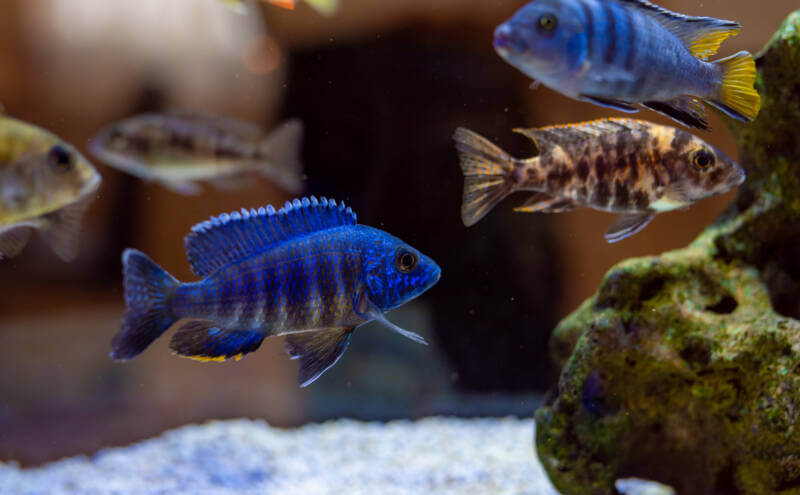
The rock helps to keep the water chemistry more like the African Rift lakes. The holes make great hiding places and escape routes for the fish. In no time they’ll set up their personal hole as a home and defend it from unwanted visitors. It gives the cichlids a sense of security too.
7. Rainbow Rock

Rainbow rocks are quite colorful, usually white and orange or white with red, black, and green. These sedimentary rocks are mined in Mexico. The rocks are sometimes sandblasted to create a hole in the center.
Rainbow rock does not look natural, but it is popular with aquarists. It is inert and won’t alter the pH, carbonate hardness, and general hardness. Rainbow rock is most often seen as a decoration in freshwater aquariums.
When quartz sandstone is heated and compressed, it forms the mineral quartzite. Iron oxide, silica, carbonate, and clay create an attractive streaking pattern.
Quartzite is used on railroad beds and for decorative purposes on walls and walkways. You’ll find polished quartzite used for kitchen countertops.
There are many trade names given to the natural color patterns in quartzite rock. You may see it sold as Onyx bamboo, Platinum black, and Glacier wave. These are just made-up names given to the color variants of quartzite. Your aquarium supplier may even make up their own names.
Quartzite is safe for soft water planted tanks and freshwater aquariums.
Some freshwater aquarists like to use plastic resin “rocks” instead of real rocks. The resin rocks are molded from plastic and come in natural stone colors. They are often sold as stackable kits that lock the pieces together.
The benefit of resin rocks is that they are very light, don’t add anything to the aquarium water, and are easy to remove and clean when necessary.
Planted aquarium enthusiasts tend to go with real rock since plants like Java moss and Anubias find it easier to attach to the natural rock surfaces. Plastic rock is popular for aquascaping small aquariums.
Reef Rock and Saltwater Aquariums
The majority of aquarists using reef rock are building a reef aquarium. The idea is to form a stable base for attaching coral frags, soft corals, and other marine life. You can use reef epoxy to stabilize your rockwork for a secure structure.
Rock for Saltwater Aquariums
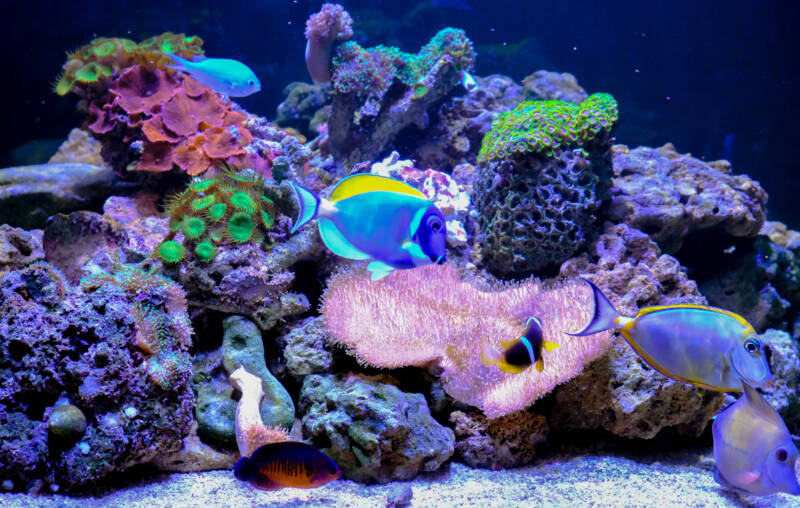
We’ve focused mostly on rock for freshwater aquariums. Saltwater aquarists desire to use decorative materials that come from the ocean. Dead coral skeleton is made of calcium carbonate but it’s not really rock, although it’s sometimes used in fish-only aquariums.
The largest users of rock are reef aquarists. They use calcium carbonate rock that is cleared from shipping lanes around tropical seaports or mined from ancient deposits.
Natural reefs are created by reef-building corals and encrusting algae. The marine life removes calcium and carbonate from the water and uses it to build a dense calcium carbonate skeleton.
Over many years reef rock is built by nature. This rock is used to recreate a reef in a marine aquarium. Base-type rock is stacked into a pile or life-like structure. There are several types of reef rock available today.
Fiji rock is the most common type of live rock used in reef tanks. It’s relatively lightweight and easy to handle.
Fiji rock is usually boat-shipped, which can take up to 30 days to arrive at the supplier’s warehouse or fish store. Much of the marine life on the rock will not survive the long trip. This means the rock has to be soaked in saltwater for a few weeks to flush the decaying marine life from the rock. Air shipments are possible but very expensive.
2. Tonga Branch Rock
Tonga Branch is a denser, heavier rock. The antler-like shape adds an interesting dimension to the layout and is best used as accent pieces. It’s used to supplement the less-branched base rock. Tonga Branch rock is often coated with live pink and purple encrusting algae.
3. Pukani Rock
Pukani rock is from Fiji but is lighter than regular Fiji rock. Pukani is quite porous. The surface is full of depressions and crevices that are great places to attach coral frags. The live rock frequently has a coating of encrusting algae.
Dry Pukani is a great building material and will eventually become coated with marine life. It’s available in larger pieces and is easily stacked to create stable shelves for corals to grow on.
4. Aquacultured Live Rock
Aquacultured live rock starts as either piece of calcium rock or man-made rubble. It is scattered in the ocean and left for several years. Over time the rock becomes colonized with marine life and looks like a natural live rock.
Aquacultured live rock is sustainable and does not harm the reef ecosystem. It usually comes from the Gulf of Mexico or the Atlantic Ocean. That means it arrives fresh and in good condition.
5. Dry Rock
Dry rock is dried live rock harvested from the ocean. Even though it is completely dry, it will leak nutrients and organics as the dead marine life decays in the water. It should be cured like live rock. Check the water for ammonia and odors during the curing process.
Life rock is a dried reef rock with a purple coating that looks like coralline algae. It gives a newly set-up reef tank a colorful appearance right away. Over time living coralline will cover the rock as the tank matures. Life rock requires no curing.
Using Rocks Found in Nature
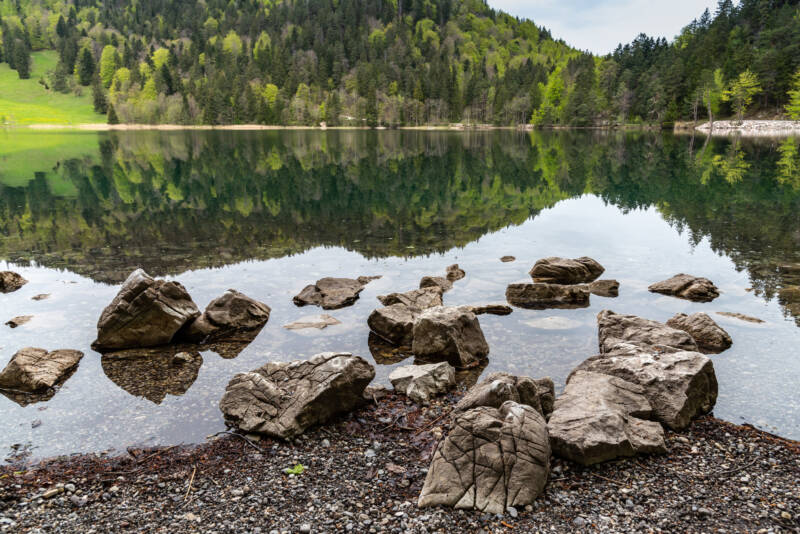
The internet is full of warnings about using rock materials from natural streams or quarries. The rationale is that rocks in the environment are loaded with diseases that will kill your fish. Rocks and pebbles collected from freshwater systems will contain a coating of biofilm comprised of algae, bacteria, and microscopic worms.
It is very unlikely that you’ll introduce a parasite or bacterial disease from rock collected from a freshwater source.
There is a much greater chance of adding pathogens to your aquarium when you add new fish than on “wild” rocks. But that doesn’t mean all rocks are suitable for the aquarium.
Reef and marine aquarists aren’t going to use freshwater rocks in their tanks, so we don’t need to discuss that scenario.
If you’re going to use rock from nature, be sure it’s not in a contaminated location. It would be foolish to select rocks from a polluted stream or an industrial area.
If the rock is covered with algae, it may make a great live food source for herbivores like pleco cats. But it could also introduce algae into your tank.
The other concern is the presence of limestone in the rock. If you’re keeping a soft water Amazonian biotope, limestone rocks will gradually raise pH, hardness, and alkalinity (carbonate hardness).
Trying to maintain a community freshwater aquarium with medium hardness and close to neutral pH could be difficult with limestone-rich rocks.
Testing Rocks for Carbonates
The easiest way to test for carbonates is with a liquid “pH Down” product.
The simple non-buffer pH lowering liquids are made of dilute sulfuric acid. Add a few drops to the rock and look for bubbles and foaming. If the rock foams, it means the carbonates are reacting with the acid.
These rocks will be great in an alkaline African cichlid tank or even a brackish aquarium. But if you’re trying to keep the water soft and pH at 7 or below, avoid carbonate rocks and stones.
Washing and Conditioning Rock
Whether you’re starting with new rock from the pet supplier, reconditioning old aquarium rocks, or using rocks from nature, it’s possible to clean them up before placing the rock in your tank. We’ll outline the most common methods from easy to extreme.
1. Scrubbing with a brush
The easiest way to clean up a rock is to scrub it with a brush under running tap water. Scrubbing loosens up organic matter, soil, algae, and rock dust from shipping. It’s also a way to clean up rocks that have become dull or dirty after sitting in your aquarium.
2. Soaking in pure water
Soaking rocks in distilled or reverse osmosis water may allow some hardness minerals to dissolve out of the rock. Carbonates locked into the structure of the rock won’t start bubbling or be neutralized by pure water.
Soaking can help flush loose minerals out of cracks and pores, but it probably won’t prevent a rock loaded with limestone from adding hardness and raising the pH.
3. Washing rocks with boiling water
Soaking the rock in boiling water will kill the biofilm and eliminate any fears of introducing “something bad” into your tank. It will also loosen dried clay and other organic matter. Boiling water can restore a rock or stone’s natural beauty.
Be careful pouring hot water as it can splash and burn your skin. Some aquarists warn that boiling stones may cause them to fracture or “explode.” Even if the explosion story is a myth, why take the chance of damaging your rocks. Just use hot tap water instead of boiling water.
4. Bleaching rock
If you’re really worried that your rock is going to introduce an unwanted life form, bleaching will kill everything and loosen up organic matter. A dilute bleach soak works for rocks and plastic plants. Just be careful not to splash the water onto your clothes, carpet, or eyes.
Once the soak is complete, it’s necessary to rinse away the residual bleach. You can either flush the rock with several buckets of water or allow the rocks to dry in the sun. Chlorine bleach will break down as the rock dries.
5. Acid washing
Soaking rocks in dilute muriatic acid (hydrochloric acid) is the “nuclear option” used to neutralize rocks containing some carbonates. Handling acid can be quite risky. It will burn your eyes, nose, and skin. Splashes will eat through your clothing.
Once the acid bath is complete, you’ll have to neutralize the acid for safe and environmentally responsible disposal.
Popular Aquarium Rocks
Here’s a list of readily available aquascaping rock for freshwater aquariums, marine tanks, and reef aquariums. You may find others but these are some of the most popular types of aquascaping rock in the aquarium hobby.
Seiryu Stone is native to Japan. It’s illegal to import true Seiryu, but convincing look-alikes are available. The stone is bluish with veins of calcite. This means the rock will gradually raise pH and water hardness if you use a lot of it.
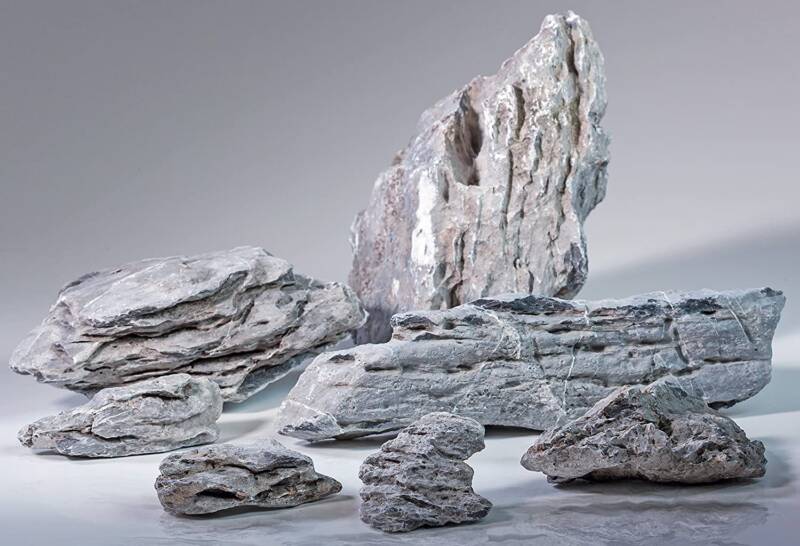
Sold in small pieces of 1 to 3-inches, this natural slate will work as a rugged gravel bed or accent substrate. The pieces are small enough to make tiny ledges. You can also epoxy the slate to the back of the aquarium, forming a rock wall.
This rock has a mountain-like shape but with red-orange tiny and contrasting veins. They make a great focus point whether used alone or in multiples. This style of rock is popular with minimalist aquascapers. They’ll use low-growing plants, giving the rock the appearance of a mountain rising above the forest.

This reef rock is fully cleaned and sun-cured. No conditioning is needed. Just arrange the pieces in your marine or reef aquarium and let nature take over.
South Sea Base Rock makes a fine foundation for building your reef tank. Coralline algae will eventually grow over the rock, giving it an attractive purple and pink color. You can glue SPS and LPS corals directly to this rock with reef epoxy.
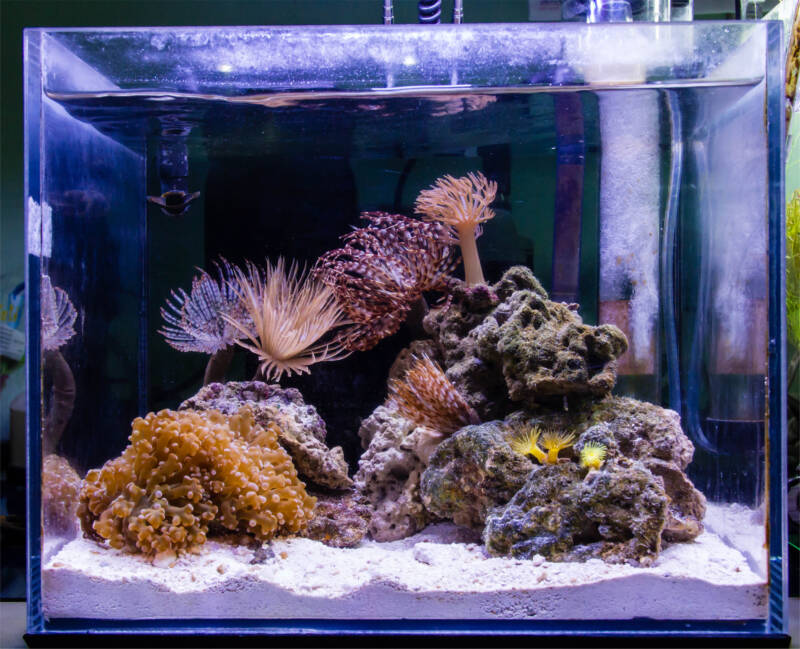
This porous reef rock originates from Florida. Each piece is hand-selected from an inland quarry containing old reef materials. The rock is power-washed to remove dust and debris.
This rock is fully cured and ready to use in a reef tank or African cichlid aquarium.

Life Rock starts out as South Sea Base Rock but receives a purple and pink coating. This makes the rock look like it’s covered with coralline algae. This gives your new reef a seasoned look. Eventually, the rock will become coated with living coralline algae and corals as your aquarium matures.
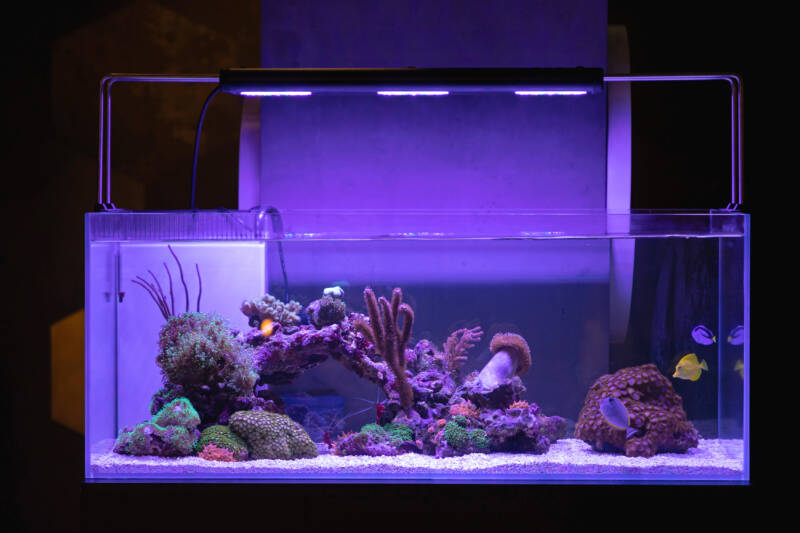
If you’ve got a fish-only saltwater tank, a coral centerpiece will add depth and curiosity to the aquascape. The bright white skeleton gives the aquarium a focus point and a place for fish to swim around.
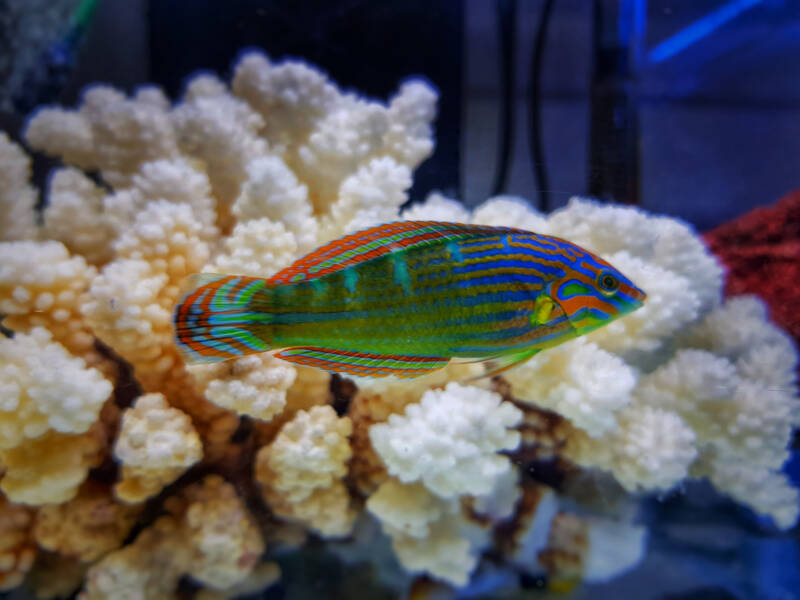
Aquarium Rock Recommendations
Aquascaping is a personal choice. Some aquarists like it bold and colorful. Others go for the subdued, natural look. Smaller aquariums will need smaller rocks to look right in the tank. If you’ve got a big aquarium look for larger rocks or build your own rockwork.
Slate has always been a popular material in freshwater aquariums. Tropical fish love to explore the caves and ledges.
More exotic Dragon stone-type rock make for an unusual aquarium where the aquascape is the main focus.
Many reef aquarists are starting their aquariums with dry rock like CaribSea Life Rock. They like the idea of not having to let the rock cure. It makes new aquarium set-up fast and easy and you don’t have to worry about die-off polluting the water.
If you have any questions or comments, please leave them below!

